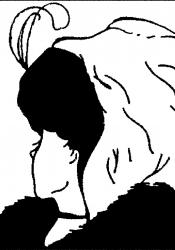"My Wife and My Mother in Law" Optical Illusion
Optical illusions play on our sense of sight. Specifically, it confuses the relation between sensation and perception. Sensation is "input about the physical world," while perception is the "process by which the brain selects, organizes, and interprets sensations (Lumen)." Perception is affected by a plethora of ideas about an individual. Perception relies on information from a person's learning, memory, emotions, and cognitive expectations. More specifically, two types of processing can occur via way of perception, and they are called bottom-up and top-down processing. Bottom-up processing is more straightforward because it is perception solely based on sensory input. In contrast, top-down processing is an interpretation of an object or image influenced by our available knowledge, experiences, and thoughts. Top-down processing relates directly to optical illusions, precisely, the ambiguous optical illusion called "My Wife and My Mother in Law." An ambiguous figure or optical illusion is an object or image that can be seen in two or more distinct ways. In this case, either an older woman or a young woman can be perceived by the viewer. These two subjects are blatantly different, and one's perspective affects how the image is seen based on their past experiences.
The image "My Wife and My Mother in Law" was initially created by an anonymous illustrator from Germany, and the picture became a postcard in 1888. Later, a British cartoonist named William Ely Hill recreated the postcard, and the image became popularized once it was published in an American magazine named Puck. Since the image is an ambiguous figure, viewers can experience a "Gestalt switch," which is the event where a person changes the image they see as a whole. It is not focused on the picture's specific details as the word "gestalt" is a German concept based on the study of things holistically. For example, Gestalt psychology is a discipline that helped advance the research of sensation and perception because it "looks at the human mind and behavior as a whole("What is Gestalt")." Even though the gestalt switch is possible, it is difficult to control due to our initial strong perception. In general, our first perception of an object relates strongly to our thoughts, experiences, and emotions, while other perspectives do not resonate as severely.
A study was conducted to see how different groups of people perceived the classic image of "My Wife and My Mother in Law." In the study, subjects were presented the image in a flash of half a second and prompted to estimate the age of the lady in the picture. Even though the study was limited to American participants, the results showed that when the observer's age increased, the estimated age of the lady increased as well. This idea supports the idea that there is a strong in-group bias present in people in general. Specifically, in this experiment, the in-groups were based on age because of the significance in how the perception of the picture led to participants expecting that the lady was roughly their own age. In general, this finding can be based on the exposure effect. The exposure effect relates to how people interpret the frequency of occurrences. Concerning "My Wife and My Mother in Law," it is estimated that younger people interact with more young people, so they are likely to recognize and ascribe pictures for younger people. In comparison, older people are likely to act similarly with other older people. However, it is essential to note that the exposure effect tends to be weaker with the older population because they are more involved with different kinds of people of all ages.
Another interesting idea to consider with "My Wife and My Mother in Law" is the idea of popular culture and general ideas of what is expected to be beautiful to the public. The original illustrator's work was published and used for a time, but the recreation is still in circulation today. Once the artwork changed by Hill and submitted to an American humor magazine, the image gained real traction. The cartoonist wants viewers of the image to perceive the young woman or "wife" as beautiful, and the older woman or "mother in law" as less than the former, as Hill attributed more cartoonish features to the woman. This degradation of the older woman was intended to be comical, but it perpetuates that youth is beauty. This concept relates strongly with The Picture of Dorian Gray as Dorian desperately tried to maintain his beauty and youth found in the portrait painted by his once friend, Basil Hallward. His obsession with beauty ruined and eventually ended his life.
Sources:
Donaldson, J. "Young Woman or Old Woman." The Illusions Index, July 2017, www.illusionsindex.org/i/young-woman-or-old-woman.
Learning, Lumen. "Sensation and Perception." Lumen, courses.lumenlearning.com/wmopen-psychology/chapter/outcome-sensation-and-perception/.
Nicholls, Michael E. R., et al. "Perception of an Ambiguous Figure Is Affected by Own-Age Social Biases." Nature News, Nature Publishing Group, 23 Aug. 2018, www.nature.com/articles/s41598-018-31129-7.
"What Is Gestalt?" Gestalt Institute of Cleveland, www.gestaltcleveland.org/what-is-gestalt.

